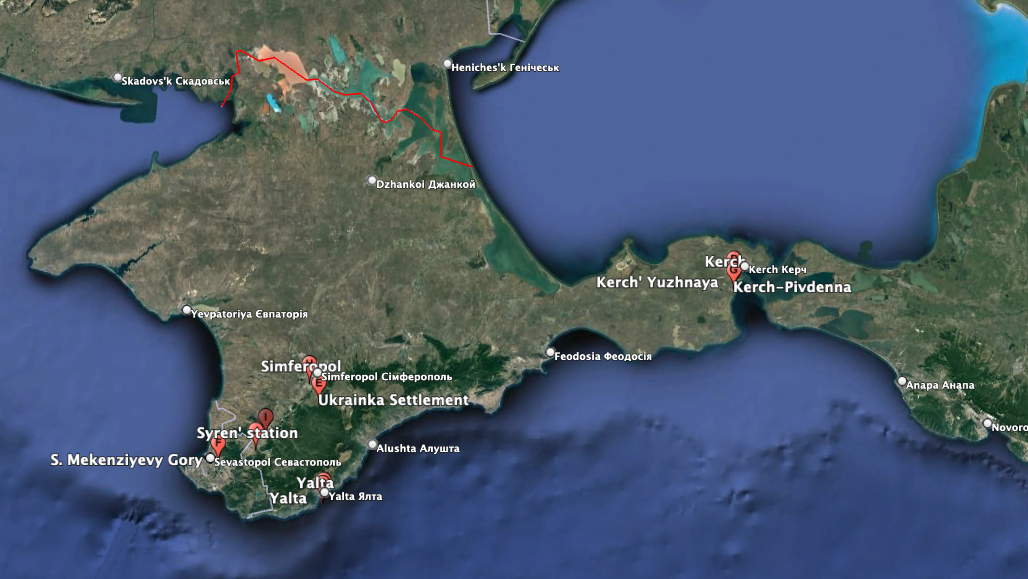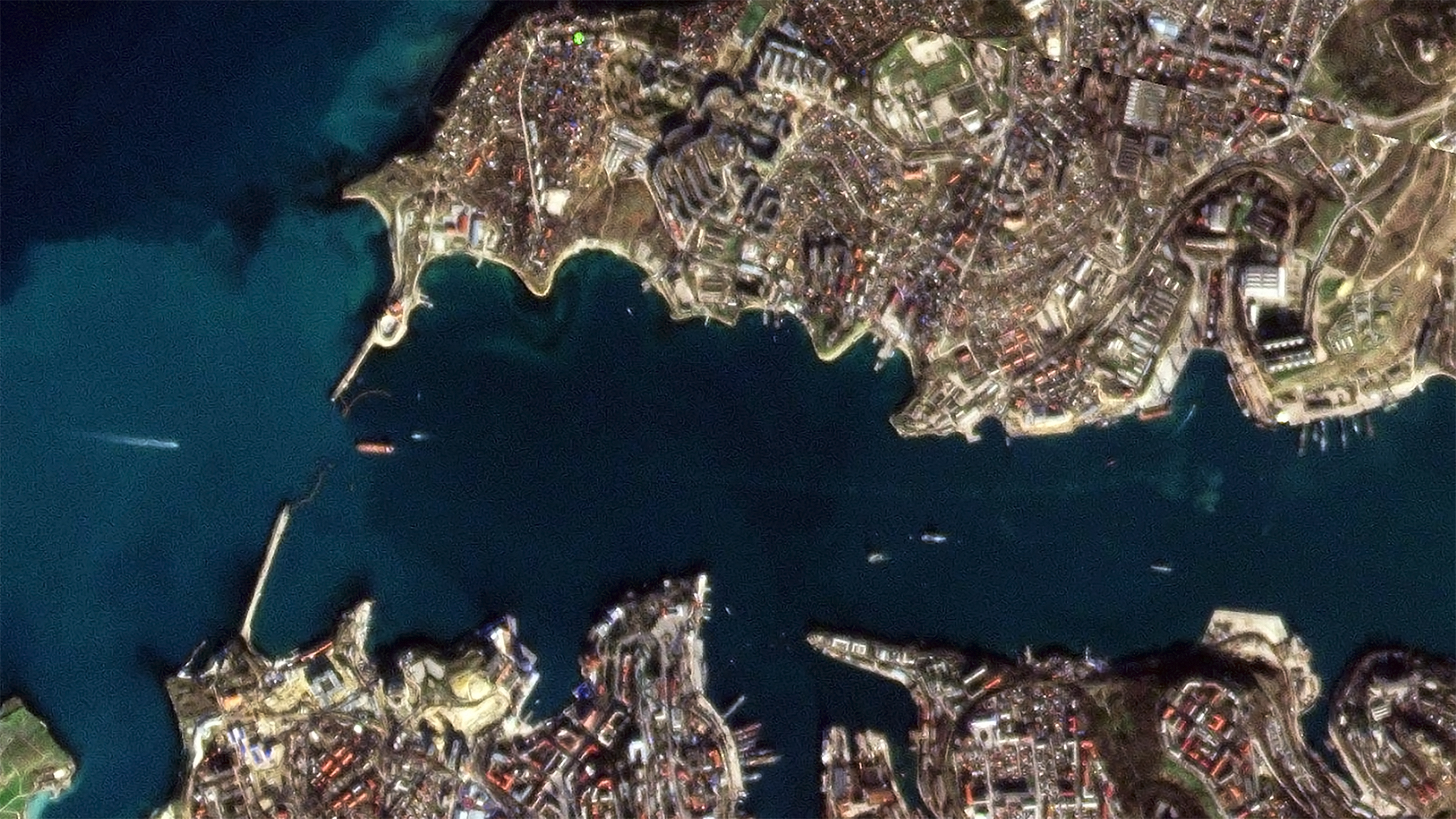Russian air defense systems in the Black Sea port city of Sevastopol on the occupied Crimean peninsula were activated Friday morning local time, the Russian-installed governor said on his Telegram channel. It was the second such incident this month at or near the headquarters of Russia’s Black Sea Fleet, which has already relocated some vessels in the wake of previous Ukrainian drone attacks.
While it is unclear what Russian air defense batteries were shooting at Friday, video and images emerged on social media of apparent air defense missiles being launched into the sky.
“In Sevastopol, the air defense system worked out,” said Sevastopol occupation governor Mikhail Razvozhayev on his Telegram channel. “All services are operating normally. Our military, as always, worked well. Everyone please remain calm.”
Sevastopol residents reported that “the windows and objects in the house were shaking,” according to the Ukrainian CrimeanWind Telegram channel. “According to eyewitnesses, [it was] the most powerful explosion of all time.”
The explosions were heard by the port, according to CrimeanWind, as a helicopter and airplane were observed in the air.
But despite the reports of explosions and signs of air defense munitions being launched, no videos or images have yet emerged showing any damage to the port or the city.
On Dec. 8, Razvozhayev reported on his Telegram channel that a Black Sea Fleet ship “shot down a drone over the sea.”
Sevastopol, about 140 miles southeast of the nearest Ukrainian forces, has been the frequent target of Ukrainian long-range drone attacks.
As Sevastopol was dealing with potential threats from the air, there were massive traffic backups in both directions heading across the Kerch Bridge, some 160 miles to the east, on the other side of the peninsula.

Traffic leaving Crimea was being tied up due to increased safety inspections in the wake of the Oct. 8 explosion that severely damaged Vladimir Putin’s prized $4 billion span linking the peninsula to Russia. Cars are being stopped and inspected by police with X-Ray wands, the CrimeanWind Telegram channel reported.
There are also about 1,200 cars entering Crimea that “are waiting for their turn to pass,” the operational headquarters of the Krasnodar Territory reported, according to Radio Free Europe / Radio Liberty’s CRIMEA.REALITIES. “As the operational headquarters of the Krasnodar Territory warned earlier, drivers should take into account that the number of vehicles has increased. As of 8 am, the traffic jam stretched for three kilometers.”
All this comes as Ukrainian leaders, including President Volodymyr Zelensky, have vowed to liberate Crimea. While no such effort appears imminent, it is clear that Ukraine is at least probing and trying to shape a future battlefield with its continued drone attacks on Crimea, something that has not gone unnoticed by occupation officials who have been digging trenches and other fortifications in preparation for any potential attack.
Before we go into the latest news from Ukraine, The War Zone readers can get caught up on our previous rolling coverage here.
The Latest
On the battlefield, despite the ongoing loss of life, neither side had made much appreciable headway toward its objectives as fighting continues in the south and east of the country.
Here are some key takeaways from the latest Institute for the Study of War Assessment.
- Repeated Ukrainian strikes on legitimate military targets in rear areas in the Russian Federation demonstrate the ineffectiveness of Russian air defenses against drones and exacerbate critiques that Russia cannot defend its own territory.
- Ukrainian forces continued counteroffensive operations near Kreminna while Russian forces conducted limited counterattacks along the Svatove-Kreminna line.
- Russian forces continued offensive operations in the Avdiivka area as well as around Bakhmut, where the potential culmination of the Russian offensive is likely being expedited.
- Russian forces continued to conduct defensive operations in Kherson Oblast.
While the U.S. has so far refused to give Ukraine Army Tactical Missile System (ATACMS), which have a range of about 200 miles, Ukrainian Foreign Minister Dmytro Kuleba on Friday hinted that they might arrive next year.
“In the next year, yes. But it will also depend on the situation on the battlefield,” he told the RBC-Ukraine news agency when asked if Ukraine would receive “tanks, ATACMS, and modern attack drones” in the next few months. A Pentagon spokesman told The War Zone Friday that it won’t comment on any arms deals before they are announced.
Ukraine, however, will definitely be getting more than 1,000 VALLON metal detectors and 100 bomb de-arming kits to Ukraine, donated by the U.K., to help clear minefields and make safe reclaimed territory, civilian homes, and infrastructure.
And count NATO Secretary General Jens Stoltenberg among those who feel Ukraine needs more weapons.
“It may sound like a paradox, but military support for Ukraine is the fastest way to peace,” he told the German DPA news agency. “We know that most wars end at the negotiating table – probably this war too – but we know that what Ukraine can achieve in these negotiations depends inextricably on the military situation. So if you want a negotiated peaceful solution ensuring that Ukraine prevails as an independent democratic state, the best way of achieving that is to provide Ukraine with military support. That’s the way to convince President Putin that he will not achieve his goal of taking control over Ukraine.”
A day after launching a massive attack on Ukraine’s power infrastructure, Russia on Friday launched another wave of drone attacks against Ukraine.
Russia unleashed 16 Shahed-136 drones, which attacked Ukraine from the southeast and north, according to Ukraine’s Defense Intelligence Directorate (GUR).
“To overcome the air defense system of Ukraine, the enemy tried to use the Dnipro direction. All 16 kamikaze drones were destroyed.”
In the wake of that attack, officials in Kyiv gathered up the remains of some of those drones, shown here in the video below:
The Russian “Two Majors” Telegram channel on Friday claimed that Ukraine likely received electronic warfare systems from the U.S. designed to combat Russian drones used to adjust artillery fire. The equipment, according to that Telegram channel, is designed to interrupt signals between the drone and the controller.
“We are unable to confirm the specific details of the Russian blogger’s statement,” the Pentagon told The War Zone Friday. “Regardless, the DOD has been focused on supporting Ukraine with air defense and anti-UAS capabilities as evidenced by the contents of several recent Presidential Drawdown announcements.”
Ukraine is working on an app/program that will automatically detect enemy soldiers in footage captured by drones. It isn’t clear how feasible or operationally impactful such a system would be. Regardless, the people behind that program talk about it in this video below by Radio Free Europe/Radio Free Liberty:

Russia is holding nearly 3,400 Ukrainian soldiers as prisoners of war, Olena Verbytska, an advisor to Ukrainian President Volodymyr Zelensky, reported.
Ukrainian forces attacked a school being used by Russian forces.
Faced with constant attacks from missiles, drones, artillery and aviation, Ukraine is building reinforced fortifications dubbed “Hobbit Holes” in an effort to provide protection against incoming threats.
What may be the first video of Polish-supplied Osa air defense systems has emerged on social media, which you can see in this video below:
Rare footage has emerged on social media of the Ukrainian-developed Bohdan 155mm howitzer. It was reportedly a live-fire test of the weapon against Russian forces.
The battle for Bakhmut will go down in history as one of the bloodiest in post World War II Europe as these images illustrate.
In Ukraine, it is apparently not unusual to see people washing infantry fighting vehicles, as you can see in this video below.
In Who If Not Us, a new documentary by NFL360, NFL Network’s Kyle Brandt explores how American football players and families in Ukraine have been forced into a harsh new reality as a result of the ongoing Russian invasion.
And finally, humor has been a shield of sorts for Ukraine during this conflict, as Radio Free Europe/Radio Free Liberty examines in this video below.
That’s it for now. We will update this story when there is anything major to add.
Contact the author: howard@thewarzone.com
